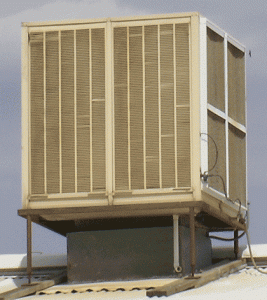Electricity rate shock more likely than blackouts this summer
by CalWatchdog Staff | May 15, 2013 9:01 am
 [1]May 15, 2013
[1]May 15, 2013
By Wayne Lusvardi
There have been many forecasts[2] of possible rolling blackouts in California this summer due to a shortage of power from the shutdown of the San Onofre nuclear power plant[3] and the instability of a green power[4] grid due to hourly weather fluctuations.
But the most likely scenario for California for the summer of 2013 is electricity price shock, especially for those moderate-income households that run air conditioners during the hot days in the Central Valley of California.
The consequence of a cleaner, greener energy system might be that renters and those with older houses cannot afford to run air conditioners or other modern household conveniences in California during hot summer months. There will be affordable energy for the very poor who get subsidies, and for the wealthy who have installed solar panels.
Everyone else will have to use the more primitive and less effective technology of swamp coolers, shift to fans, or just plain sweat it out during the summer months as the price paid for green power, clean skies and a politically rigged rate structure. Parts of California may regress to a pre-modern state, while wealthier areas won’t feel the heat at all. And those on fixed incomes and welfare won’t feel it much either due to the California Alternate Rates for Energy [5]plan.
Electricity rates that have ramped up to 50 cents per kilowatt-hour for Pacific Gas & Electric customers in the top rate tier in 2010[6]. That mainly was caused by rate subsidies given low-income customers after the California Energy Crisis of 2001.
Overall, California wholesale electricity prices have declined[7] due to a shift to cheap natural gas. But those in the higher tiers of electricity usage didn’t benefit from that during hot summer months.
And because of such deep subsidies to those in the lowest rate tiers, there is no benefit from conservation. The lower-income customer and higher-income solar-powered homeowner can run their air conditioners all day and the renters and older homeowners can’t afford to. The wealthy that can afford to live along the coast won’t feel the heat as much and neither will the wealthy “inlanders,” who will pay huge electricity bills during summer months.
Renters and those with older homes that are not suitable for solar panels have been politically selected to pay for most of the rate shock. Old houses were made to breathe and insulating them for solar power can result in air moisture and mold buildup[8].
How energy pricing and usage system works in California
Electricity usage rates are approved every three years in California for customers living in areas served by regulated electric utilities, Pacific Gas & Electric, Southern California Edison and San Diego Gas & Electric. Each regulated utility has tiered rates depending on how much power is used in order to conserve power.
But customers in cooler climate zones have lower usage base baselines while those in hotter climate zones have higher usage baselines. By allowing more use of electricity in hotter areas at relatively lower rates, those most affected by hot weather can afford to run their air conditioners more hours each month.
The way the tiered usage system works can be seen in the table below. PG&E customers living in hot Merced in the summer months are allowed to use twice as much power at the same rate as those who live in cooler San Francisco.
How California Sets Rates for Customers of Regulated Electric Power Companies
| Tier 1 Baseline | Tier 2 | Tier 3 | Tier 4 | Tier 5 | |
| Up to baseline | 101-130% | 131-200% | 201-300% | 300%> | |
| Rate per kilowatt hour | 13 cents | 15 cents | 30 cents | 34 cents | 34 cents |
| San Francisco (cooler) | 0 to 225 kilowatt hours | 226 to 293 kilowatt hours | 294 to 450 kilowatt hours | 451 to 675 kilowatt hours | 676+ kilowatt hours |
| Merced (warmer) | 0 to 513 kilowatt hours | 514 to 667 kilowatt hours | 668-1026 kilowatt hours | 1027 to 1539 kilowatt hours | 1540+ kilowatt hours |
| Source: Little Hoover Commission, Rewiring California, 2012, p. 40[9]. | |||||
Connected get solar panels, the unnconnected get swamp coolers
There isn’t much that policy makers are doing to lessen rate shock for the most affected. Installing older technology like evaporative “swamp” coolers in older homes could reduce peak month power bills by 80 to 90 percent. At least with a rooftop swamp cooler a homeowner gets both clean, fresh air and low C02 emissions.
But California public policy more promotes contrived solar jobs programs and energy cost shifting onto renters and older homeowners, than helping them to reduce rate shock. And renters in older apartment buildings will mostly be left to bake for the summer of 2013 unless they can install cheaper window air conditioners and isolate themselves in one room.
- [Image]: http://www.calwatchdog.com/2013/05/15/electricity-rate-shock-more-likely-than-blackouts-this-summer/evaporative-cooler/
- many forecasts: http://www.bloomberg.com/news/2013-04-19/california-power-facing-biggest-test-since-enron-energy-markets.html
- San Onofre nuclear power plant: http://www.forbes.com/sites/kensilverstein/2013/05/09/californias-new-energy-crisis-centers-on-nuclear-energy/
- green power: http://online.wsj.com/article/SB10001424127887324582804578344500414630778.html
- California Alternate Rates for Energy : http://www.pge.com/care/
- 50 cents per kilowatt-hour for Pacific Gas & Electric customers in the top rate tier in 2010: http://www.sacbee.com/2013/02/22/5208338/californias-electric-rate-system.html
- California wholesale electricity prices have declined: http://www.managingpowermag.com/supply_chains/TREND-Down-Go-Electricity-Prices_440.html
- air moisture and mold buildup: http://blogs.scientificamerican.com/solar-at-home/2010/03/26/are-old-houses-doomed-the-conflict-between-historic-preservation-and-energy-efficiency/
- Little Hoover Commission, Rewiring California, 2012, p. 40: http://www.lhc.ca.gov/studies/214/Report214_Final%20Complete.pdf
Source URL: https://calwatchdog.com/2013/05/15/electricity-rate-shock-more-likely-than-blackouts-this-summer/